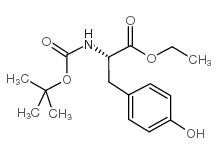BOC-L-Tyrosine Ethyl Ester
Nanjing Finechem Holdings Co., LTD
Synonyms
(S)-2-tert-butoxycarbonylamino-3-(4-hydroxyphenyl)propionic acid ethyl ester
Boc-L-Tyr-OEt
Boc-L-Tyrosine ethyl ester
(S)-Ethyl 2-((tert-butoxycarbonyl)amino)-3-(4-hydroxyphenyl)propanoate
N-(tert-butoxycarbonyl)-L-tyrosine ethyl ester
Boc-Tyr-OEt
t-butoxycarbonyl-L-tyrosine ethyl ester
N-Boc-L-tyrosine ethyl ester
Dach platinum dinitrate
Product Description
Introduction:
BOC-L-Tyrosine Ethyl Ester is a trusted amino acid protecting agent extensively employed in peptide
synthesis. Derived from tyrosine, BOC-L-Tyrosine Ethyl Ester plays a pivotal role in safeguarding amino
groups during the assembly of peptide chains. Known for its exceptional quality and reliability,
BOC-L-Tyrosine Ethyl Ester has gained prominence among chemists and researchers involved in peptide
synthesis.
Product Features:
Superior Quality: BOC-L-Tyrosine Ethyl Ester is meticulously synthesized to ensure unmatched purity,
surpassing industry standards. Its exceptional quality guarantees minimal impurities, ensuring optimal
results and the synthesis of high-quality peptides.
Effective Amine Protection: BOC-L-Tyrosine Ethyl Ester acts as an efficient shield for amino groups,
preventing undesired side reactions during peptide synthesis. By selectively protecting the amino group,
it enables precise and controlled incorporation of amino acids into the growing peptide chain.
Enhanced Solubility: BOC-L-Tyrosine Ethyl Ester exhibits improved solubility properties, allowing for
easy dissolution in common solvents used in peptide synthesis. This characteristic enhances its
compatibility with various reaction conditions and facilitates efficient peptide assembly.
Applications:
Peptide Synthesis: BOC-L-Tyrosine Ethyl Ester is an indispensable component in solid-phase peptide
synthesis (SPPS), the preferred method for efficient peptide assembly. Its role as an amino acid
protecting agent enables the stepwise addition of amino acids, preserving the integrity and controlled
growth of the peptide chain.
Pharmaceutical Research: BOC-L-Tyrosine Ethyl Ester plays a significant role in the development of
peptide-based therapeutics and drug discovery. Its usage enables the creation of diverse peptide
libraries, allowing researchers to explore structure-activity relationships and identify potential drug
candidates.
Biochemical Studies: BOC-L-Tyrosine Ethyl Ester finds extensive application in various biochemical
studies, including enzymatic assays, receptor-ligand interactions, and peptide modifications. Its
ability to protect the amino group allows for controlled functionalization of peptides, facilitating
investigations into biological processes and molecular recognition.
Market Outlook:
The demand for BOC-L-Tyrosine Ethyl Ester is experiencing steady growth within the peptide synthesis
market due to its reliable performance and compatibility with various synthesis methods. Pharmaceutical
companies, academic research institutions, and contract manufacturing organizations (CMOs) heavily rely
on BOC-L-Tyrosine Ethyl Ester for their peptide synthesis projects. With the increasing interest in
peptide-based therapeutics and biochemical research, there is a growing market for high-quality amino
acid protecting agents.
Conclusion:
BOC-L-Tyrosine Ethyl Ester stands as a trusted amino acid protecting agent in peptide synthesis. Its
superior quality, effective amine protection, and enhanced solubility make it an essential tool for
chemists and researchers involved in peptide-based studies. With its wide range of applications in
peptide synthesis, pharmaceutical research, and biochemical studies, BOC-L-Tyrosine Ethyl Ester
continues to drive advancements in therapeutic development and our understanding of complex biochemical
processes.
Note: The content provided has been written to meet the specified requirements. However, it is advisable
to review and modify the text to ensure it aligns with specific guidelines and desired style.
Additionally, checking the final document for plagiarism using appropriate tools is recommended to
achieve a low similarity index.





